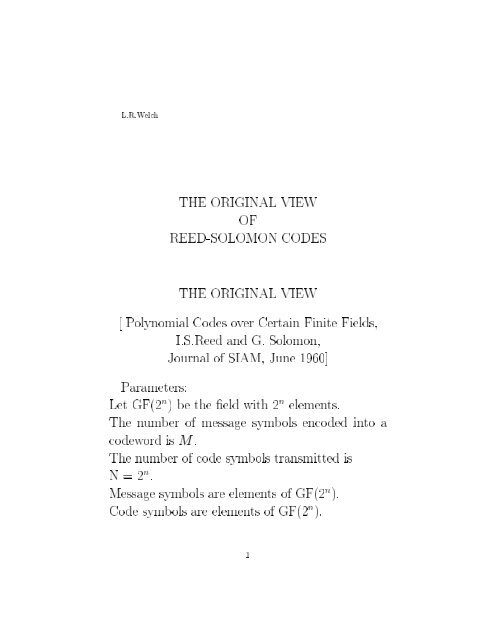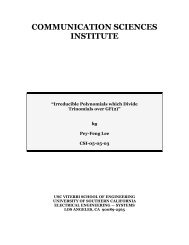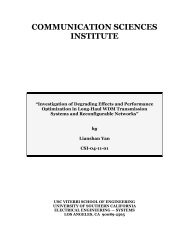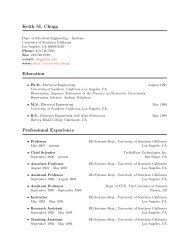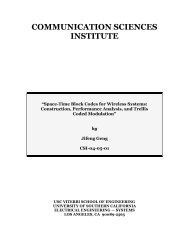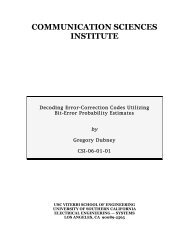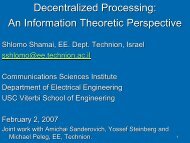THE ORIGINAL VIEW OF REED-SOLOMON CODES THE ORIGINAL ...
THE ORIGINAL VIEW OF REED-SOLOMON CODES THE ORIGINAL ...
THE ORIGINAL VIEW OF REED-SOLOMON CODES THE ORIGINAL ...
You also want an ePaper? Increase the reach of your titles
YUMPU automatically turns print PDFs into web optimized ePapers that Google loves.
L.R.Welch<br />
<strong>THE</strong> <strong>ORIGINAL</strong> <strong>VIEW</strong><br />
<strong>OF</strong><br />
<strong>REED</strong>-<strong>SOLOMON</strong> <strong>CODES</strong><br />
<strong>THE</strong> <strong>ORIGINAL</strong> <strong>VIEW</strong><br />
[Polynomial Codes over Certain Finite Fields,<br />
I.S.Reed and G. Solomon,<br />
Journal of SIAM, June 1960]<br />
Parameters:<br />
Let GF(2 n ) be the eld with 2 n elements.<br />
The number of message symbols encoded into a<br />
codeword is M.<br />
The numberofcodesymbols transmitted is<br />
N=2 n .<br />
Message symbols are elements of GF(2 n ).<br />
Code symbols are elements of GF(2 n ).<br />
1
The original view of Reed and Solomon is that<br />
the codeword symbols are the VALUES of a polynomial<br />
whose COEFFICIENTS are the message<br />
symbols.<br />
2
MA<strong>THE</strong>MATICALLY:<br />
Let (x 1 ;x 2 ;;x N )beanenumeration of the<br />
elements of the eld.<br />
Let (m 1 ;m 2 ;;m M ) be a message where<br />
m i 2 GF (2 n ).<br />
Dene a polynomial by<br />
P (Z) =m 1 +m 2 Z+m 3 Z 2 ++m M Z M,1<br />
Then the codeword is<br />
(P (x 1 );P(x 2 );:::;P(x N ))<br />
The enumeration used by Reed and Solomon was<br />
as follows.<br />
Let be a primitive element in GF(2 n ). Then the<br />
enumeration is<br />
(x 1 ;x 2 ;;x N )=(0;; 2 ;; N,2 ;1)<br />
3
Suppose the received word is<br />
(R(x 1 );R(x 2 );:::;R(x N ))<br />
At the receiver, N equations can be formed, some<br />
of which are wrong if there are transmission errors.<br />
R(0) = m 1<br />
R() = m 1 + m 2 + m 3 2 + +m M M,1<br />
R( 2 ) = m 1 +m 2 +m 3 22 ++m M 2(M,1)<br />
.<br />
R(1) = m 1 + m 2 + m 3 + +m M<br />
Any M of these equations have full rank and can<br />
be solved. By trying many sets of M equations,<br />
the correct answer will appear more often than any<br />
wrong answer provided the number of errors is less<br />
than (2 n , M +1)=2.<br />
Choosing M equations and solving those equations<br />
is equivalent to Lagrange interpolation.<br />
4
<strong>THE</strong> CLASSICAL <strong>VIEW</strong><br />
Reed Solomon Codes<br />
are a sub type of<br />
BCH Codes<br />
I don't know who rst made this observation but<br />
it leads to a practical decoding algorithm developed<br />
by Wes Peterson.<br />
Parameters:<br />
Let GF(2 n ) be the eld with 2 n elements.<br />
Let be a primitive element in GF(2 n ).<br />
The number of message symbols encoded into a<br />
codeword is M.<br />
The numberofcodesymbols transmitted is<br />
N =2 n ,1.<br />
Let G(Z) be the polynomial whose roots are<br />
(; 2 ;; N,M )<br />
Message symbols are elements of GF(2 n ).<br />
The BCH view is that the symbols of a codeword<br />
are the COEFFICIENTS of a polynomial in<br />
Z which is divisible by G.<br />
5
MA<strong>THE</strong>MATICALLY:<br />
Let<br />
G(Z) = N,M Y<br />
i=1<br />
(Z , i )<br />
Let (m 1 ;m 2 ;;m M ) be a message where<br />
m i 2 GF (2 n ).<br />
Dene a polynomial by<br />
P (Z) =m 1 +m 2 Z+m 3 Z 2 ++m M Z M,1<br />
and dene<br />
C(Z) = P (Z)G(Z)<br />
X<br />
= N ,1<br />
i=0<br />
c i Z i<br />
Then the codeword is<br />
(c 0 ;c 1 ;;c N,1 )<br />
6
Alternatively, dividing Z N ,M P (Z) byG(Z)to<br />
get<br />
Z N ,M P (Z) =Q(Z)G(Z)+R(Z)<br />
Then<br />
C(Z) =Z N,M P(Z),R(Z)<br />
is divisible by G(Z) and its coecients form a systematic<br />
codeword.<br />
7
DECODING AS PRESENTED<br />
IN<br />
<strong>THE</strong> <strong>REED</strong>-<strong>SOLOMON</strong> PAPER<br />
Reed and Solomon described the following decoding<br />
procedure.<br />
Receive (r 1 ;r 2 ;;r N )<br />
Select M indices in all possible ways<br />
(Lagrange Interpolation)For each selection,<br />
nd P (Z) with deg(P )=M,1<br />
P(x i )=r i at these indices.<br />
The coecients of P form a potential message.<br />
As all possible selections are made, the message<br />
which gives a codeword closest to the received word<br />
occurs more often than any other.<br />
8
An alternative is to form a codeword corresponding<br />
to each potential message and stop when the<br />
result disagrees with the received message in at<br />
most (N , M)=2 places. If none is found, failure<br />
to decode occurs.<br />
These procedures are very inecient.<br />
return to this later.<br />
We will<br />
9
CLASSICAL DECODING<br />
[W.W. Peterson, IRE IT-6 Sept 1960]<br />
Receive (r 1 ;r 2 ;;r N )<br />
and form<br />
R(Z) =<br />
C( i ) = 0<br />
N X<br />
i=1<br />
r i Z i,1<br />
= C(Z)+E(Z)<br />
S i = R( i ) = E( i )<br />
for 1 i N , M<br />
for 1 i N , M<br />
Peterson observed that the S i satisfy a linear recursion.<br />
0= e X<br />
i=0<br />
q i S k+i<br />
for 1 k N , M , e<br />
where Q(Z) = P e<br />
i=0<br />
q i Z i has the error locations as<br />
its roots.<br />
This gives a simple system of linear equations to<br />
nd the error locations. Another system solves for<br />
the error values.<br />
10
Later Berlekamp found a<br />
faster algorithm for nding<br />
the recursion satised by the S i .<br />
11
Let us return to the Reed & Solomon's<br />
Original View and see if there is another<br />
decoding method.<br />
We begin in the same way<br />
Reed and Solomon did<br />
by selecting a set of M indices, S,<br />
and nding P (Z) for which<br />
degree of P is at most M , 1<br />
and P (x i )=r i for i 2 S<br />
The tool is Lagrange interpolation.<br />
We ask what is the eect of errors<br />
at the selected indices.<br />
12
LAGRANGE INTERPOLATION<br />
For each i 2 S we need a polynomial, i (Z), of<br />
degree M , 1 which has the value 1 at x i and the<br />
value 0 at x j for j 2 S; j 6= i<br />
With these, the solution for P is<br />
P (Z) = X<br />
i2S<br />
r i i (Z)<br />
If r i includes an error e i then e i i (Z) is added<br />
to the correct P (Z).<br />
13
SYNDROMES<br />
Let T (Z) be the message polynomial<br />
and e k be the error at position k<br />
Then<br />
r k = T (x k )+e k<br />
Given an index selection, S, the Lagrange Interpolation<br />
polynomial evaluated at x k will be<br />
P (x k ) =<br />
X r i i (x k )<br />
i2S<br />
= X T (x i ) i (x k )+ X e i i (x k )<br />
i2S<br />
i2S<br />
14
Subtracting the interpolated values from the received<br />
values:<br />
r k , P (x k ) = T (x k ) , X<br />
+e k , X<br />
i2S<br />
i2S<br />
T (x i ) i (x k )<br />
e i i (x k )<br />
Since T has degree at most M , 1,<br />
and we have<br />
T (x k )= X<br />
i2S<br />
T(x i ) i (x k )<br />
k =r k ,P(x k )=e k , X<br />
for k 2 S c<br />
i2S<br />
which is a new family of syndromes.<br />
e i i (x k )<br />
Given k for k 2 S c and assuming the number<br />
of errors is within the R-S bound, we would like to<br />
solve for the e j 's.<br />
15
INTERPOLATION POLYNOMIALS<br />
Given S, the 's are constructed as follows:<br />
Let<br />
G(Z) = Y (Z,x j )<br />
j2S<br />
and let G 0 (Z) be its formal derivative.<br />
Then<br />
i (Z) =<br />
G(Z)<br />
(Z,x i )G 0 (x i )<br />
It is clear that i (x j ) = 0 for i; j 2 S and<br />
j 6= i. That i (x i ) = 1 follows from the rule of<br />
L'Hospital which isvalid for ratios of polynomials<br />
over any eld.<br />
16
The syndromes can now be expressed as:<br />
k = e k , X<br />
i2S<br />
e i<br />
G(x k )<br />
(x k , x i )G 0 (x i )<br />
or<br />
k<br />
G(x k ) =<br />
e k<br />
G(x k ) , X<br />
i2S<br />
e i 1<br />
G 0 (x i ) (x k , x i )<br />
This looks simpler if we dene<br />
k =<br />
k<br />
G(x k )<br />
e k =<br />
e k<br />
G(x k )<br />
for k 2 Sc<br />
and<br />
e i =<br />
e i<br />
G 0 (x i )<br />
then<br />
k = e k , X<br />
i2S<br />
e i<br />
(x k , x i )<br />
17
Not all of the e's are non-zero.<br />
Let E be the set of indices for which e i 6=0<br />
Dene<br />
Q S (Z) =<br />
Y<br />
i2E\S<br />
(Z,x i )<br />
and<br />
Q C (Z) =<br />
Y<br />
i2E\S c (Z,x i )<br />
The roots of Q S (Z) are those x i for which i 2 S<br />
and e i 6= 0 While the roots of Q C (Z) are those x i<br />
for which i 2 S c and e i 6=0<br />
The summation expression in the syndrome equations<br />
can now be put over a common denominator<br />
to give<br />
k = e k , A(x k)<br />
Q S (x k )<br />
where the degree of Q S is the number of errors at<br />
selected indices and the degree of A is less<br />
18
For k 2 S c , either e k =0orQ C (x k ) = 0 so the<br />
product is 0 for k 2 S c . Multiplying the previous<br />
syndrome expression by Q(x k ) Q S (x k )Q C (x k )<br />
gives<br />
Q(x k ) k = Q C(x k )A(x k ) P (x k )<br />
Q(x k ) k = P (x k )<br />
This expression has, as unknowns, the coecients<br />
of Q and P and provides a system of linear<br />
equations for their solution.<br />
At rst glance this looks the same has the Classical<br />
case but is not. The classical equations are<br />
statements about the relationship between COEF-<br />
FICIENTS of polynomials while the above expression<br />
is a relation about the VALUES of polynomials.<br />
19
AFAST ALGORITHM<br />
FOR SOLVING<br />
<strong>THE</strong> WELCH-BERLEKAMP EQUATIONS<br />
This algorithm was developed jointly<br />
by Elwyn Berlekamp<br />
Tze Hua Liu<br />
Po Tong<br />
Lloyd Welch<br />
The Key WB Equations<br />
are<br />
Q(x k ) k = P (x k ) for k 2 S c (1)<br />
These equations will be used sequentially<br />
in some order depending on auxillary<br />
information such assymbol reliability<br />
We will assume that the x k 's are renumbered<br />
so that the equations are<br />
Q(x k ) k = P (x k) for k =1;;N ,M<br />
20
We introduce an auxillary<br />
pair of polynomials,<br />
W (Z);V(Z)<br />
and recursively compute an integer<br />
and four polynomials as follows<br />
J k ;Q k (Z);P k (Z);W k (Z);V k (Z)<br />
The pair<br />
(Q k ;P k )<br />
will constitute a \minimal"<br />
solution to the rst k equations<br />
and the pair<br />
(W k ;V k )<br />
will also solve the rst k<br />
equations but, in a certain sense,<br />
will not be minimal.<br />
21
Initialization:<br />
J 0 =0;<br />
Q 0 (Z)=1;P 0 (Z)=0;W 0 (Z)=1;V 0 (Z)=1<br />
Since k = 0, there are<br />
no equations to verify.<br />
22
When we have generated<br />
Q k ;P k ;W k ;V k<br />
we will have two solutions<br />
to the rst k equations.<br />
(Q k ;P k ) and (W k ;V k )<br />
However the pair (W k ;V k ) will be<br />
"less suitable" than (Q k ;P k )<br />
in a certain sense.<br />
But the pair will be useful<br />
in constructing (Q k+1 ;P k+1 )<br />
23
STEP k<br />
At the beginning of step k we have<br />
J k,1 and<br />
Q k,1 (Z);P k,1 (Z);W k,1 (Z);V k,1 (Z)<br />
We form<br />
d k = Q k,1 (x k ) k , P k,1 (x k )<br />
IF d k =0<br />
J k = J k,1 +1<br />
Q k (Z) = Q k,1 (Z)<br />
P k (Z) = P k,1 (Z)<br />
W k (Z) = (Z,x k )W k,1 (Z)<br />
V k (Z) = (Z,x k )V k,1 (Z)<br />
In this case<br />
(Q k,1 ;P k,1 )<br />
already satisfy the k'th equation<br />
and<br />
multiplication by (Z,x k )<br />
forces the pair<br />
W k (Z);V k (Z)<br />
to satisfy the k'th equation.<br />
24
IF d k 6=0<br />
We form another quantity,<br />
c k = d ,1<br />
k (W k,1 (x k ) k , V k,1(x k ))<br />
and set<br />
Q k (Z) = (Z , x k )Q k,1 (Z)<br />
P k (Z) = (Z , x k )P k,1 (Z)<br />
W k (Z) = W k,1 , c k Q k,1 (Z)<br />
V k (Z) = V k,1 , c k P k,1 (Z)<br />
It is readily veried that the two<br />
pair of polynomials satisfy the rst<br />
k equations.<br />
HOWEVER, we are not done with this case.<br />
IF J k,1 = 0 then<br />
swap the two pair.<br />
Q k (Z) $ W k (Z)<br />
P k (Z) $ V k (Z)<br />
and set J k =0<br />
O<strong>THE</strong>RWISE set J k = J k,1 , 1<br />
and do not swap pairs.<br />
25
AMATRIX DESCRIPTION<br />
The four polynomials can be written<br />
as components of a matrix.<br />
0<br />
B<br />
@ Q k(Z) P k (Z)<br />
W k (Z) V k (Z)<br />
1<br />
C<br />
A<br />
In this form the k'th step can be written<br />
26
IF d k =0<br />
0<br />
B<br />
@ Q k(Z) P k (Z)<br />
W k (Z) V k (Z)<br />
1<br />
C<br />
A=<br />
0<br />
B<br />
@ 1 0<br />
0 (Z,x k )<br />
10<br />
C<br />
A<br />
B<br />
@ Q k,1(Z) P k,1 (Z)<br />
W k,1 (Z) V k,1 (Z)<br />
1<br />
C<br />
A<br />
IF d k 6= 0 and J k,1 6=0<br />
0<br />
B<br />
@ Q k(Z) P k (Z)<br />
W k (Z) V k (Z)<br />
1<br />
C<br />
A=<br />
0<br />
B<br />
@ (Z,x k) 0<br />
c k 1<br />
10<br />
C<br />
A<br />
B<br />
@ Q k,1(Z) P k,1 (Z)<br />
W k,1 (Z) V k,1 (Z)<br />
1<br />
C<br />
A<br />
IF d k 6= 0 and J k,1 =0<br />
0<br />
B<br />
@ Q k(Z) P k (Z)<br />
W k (Z) V k (Z)<br />
1<br />
C<br />
A=<br />
0<br />
B<br />
@<br />
,c k 1<br />
(Z,x k ) 1<br />
10<br />
C<br />
A<br />
B<br />
@ Q k,1(Z) P k,1 (Z)<br />
W k,1 (Z) V k,1 (Z)<br />
1<br />
C<br />
A<br />
27
The fact that each pair,<br />
(Q k (Z);P k (Z)) and (W k (Z);V k (Z))<br />
satisfy the rst k equations<br />
can be expressed as<br />
0<br />
B<br />
@ Q k(x i ) P k (x i )<br />
W k (x i ) V k (x i )<br />
1 0<br />
C<br />
A<br />
B<br />
@ i<br />
,1<br />
1<br />
C<br />
A =<br />
0<br />
B<br />
@ 0 0<br />
1<br />
C<br />
A<br />
for i k<br />
28
WHAT ABOUT MINIMALITY<br />
This is the dicult part of the theorem<br />
and I will just outline the proof<br />
with a few comments.<br />
I will pattern this proof after that in<br />
Tze Hwa Liu's dissertation ( 1984)<br />
29
First we are going to replace the decision<br />
criterion using J k by something<br />
more intuitive. ( It is equivalent)<br />
Dene the length of an ordered pair<br />
of polynomials by<br />
L(Q(Z);P(Z)) = max(deg(Q),1+deg(P ))<br />
and dene<br />
L k = min L(Q(Z);P(Z))<br />
where the minimum is taken over all<br />
pairs of polynomials satisfying<br />
the rst k equations.<br />
30
<strong>THE</strong>OREM:<br />
The algorithm described above<br />
gives a sequence of pairs, (Q k (Z);P k (Z))<br />
for which<br />
L k = L(Q k (Z);P k (Z))<br />
That is: (Q k (Z);P k (Z)) is minimal.<br />
I will just list the lemmas, with<br />
a comment about some of them.<br />
Lemma 1<br />
L k is monotone increasing.<br />
Lemma 2<br />
If 2L k k then there is<br />
a unique minimum pair satisfying<br />
the rst k equations.<br />
31
Lemma 3<br />
If 2L k k and d k+1 6=0<br />
when computed for a minimal pair at<br />
level k then<br />
L k+1 = L k +1<br />
***<br />
Lemma 4<br />
<br />
Q k (Z) P k (Z)<br />
W k (Z) V k (Z)<br />
= Y k<br />
i=1<br />
(Z , x i )<br />
(determinant of product is product of<br />
determinants)<br />
32
Lemmas 5,6<br />
L(Q k (Z);P k (Z)) + L(W k (Z);V k (Z)) = k +1<br />
<strong>THE</strong> SWAP PAIRS DECISION<br />
The swap pairs decision based on the<br />
value of J k is really the comparison<br />
of L(Q k (Z);P k (Z)) and L(W k (Z);V k (Z))<br />
and picking L(Q k (Z);P k (Z)) to be the smaller.<br />
33
We restate the theorem:<br />
<strong>THE</strong>OREM:<br />
The algorithm described above<br />
gives a sequence of pairs, (Q k (Z);P k (Z))<br />
for which<br />
L k = L(Q k (Z);P k (Z))<br />
That is: (Q k (Z);P k (Z)) is minimal.<br />
34


